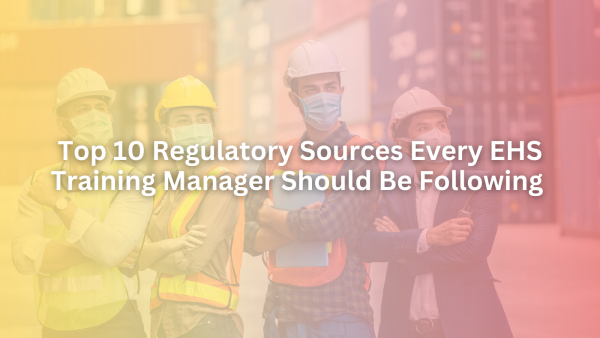
In today's rapidly changing world of Environmental, Health, and Safety (EHS) management, keeping current with recent regulatory developments is not only necessary, but also imperative to the mission. Training managers who use stale knowledge risk putting their workforce at risk and their companies at risk of legal consequences. To prevent this, every EHS training manager must personally track reliable regulatory sources that offer insights, that are:
- Consistent
- Timely, and
- Pragmatic
For organizations implementing an LMS for EHS training, these sources are the foundation for maintaining:
- Content accuracy
- Compliance, and
- Applicability
So, EHS training managers, if you want to keep your workers safe and your company in compliance, then keeping your finger on the pulse of the leading regulatory sources isn't just a good idea – it's downright non-negotiable.
The Essential Blueprint for Every EHS Training Manager
By keeping a constant eye on these invaluable governmental and industry watchdogs, not only do you keep your training programs strong and up to date but also actively protect your company from potential legal traps and advance its safety culture. These 10 Regulatory Sources are not dry legal texts; they're the living blueprints for:
- Accident prevention
- Evasion of costly fines
- Genuine instructions for a safe and sustainable work culture
The following authoritative sources offer vital updates that directly inform your training curriculum and protect your entire operation. So, without any further delays you can start ensuing the best precautions from these Top 10 Regulatory Sources every EHS training manager must track:
1. Occupational Safety and Health Administration (OSHA)
Why subscribe? OSHA establishes and administers workplace safety regulations in the U.S. Its site is regularly refreshed with:
- Fresh rules
- Compliance guidance
- Training material
- Enforcement policy
OSHA updates can be incorporated by LMS administrators to make online courses compliant with current regulations.
2. Environmental Protection Agency (EPA)
Why Subscribe? The EPA oversees chemical safety and environmental health, it offers:
- Critical news on hazardous chemicals
- Waste disposal, and
- Environmental regulation
All of these are substantially important for EHS professionals. Introducing EPA tools into your LMS will keep your training modules in accordance with sustainability and regulatory mandates.
3. National Institute for Occupational Safety and Health (NIOSH)
Why Follow? NIOSH is concerned with research and recommendations to avoid occupational illness and injury, by offering:
- NIOSH publications
- Exposure standards
- Training materials
These are priceless instruments in creating powerful LMS-based EHS training programs.
4. American National Standards Institute (ANSI)
Why Follow? ANSI promulgates voluntary consensus standards that affect safety procedures among industries. ANSI standards can be used by EHS managers to:
- Reinforce LMS course content
- Train for exams
5. International Labour Organization (ILO)
Why Follow? For multinational firms, the ILO offers international safety and labor standards, research reports, and policy recommendations. These can be integrated into LMS courses for ensuring multinational compliance.
6. European Agency for Safety and Health at Work (EU-OSHA)
Why Subscribe? For companies based in Europe, EU-OSHA offers essential information on:
- Workplace hazards
- Regulations
- Useful tools
EHS training managers can utilize these to renew LMS courses for teams in Europe.
7. Canadian Centre for Occupational Health and Safety (CCOHS)
Why Subscribe? Canadian or cross-border EHS managers can count on CCOHS for:
- Compliance materials
- E-learning courses
- Regulatory information
These can be integrated directly into an LMS.
8. Hazard Communication Standards (GHS/UN)
Why Subscribe? Globally Harmonized System (GHS) offers chemical classification and labeling standards. Organizations align LMS modules with UN GHS revisions to ensure chemical safety programs are international best practice compliant.
9. Safety and Health Magazine (National Safety Council)
Why Subscribe? In addition to compliance, EHS professionals learn from the standard publications such as Safety+Health Magazine, that presents:
- Industry news
- Case studies
- Best practices
LMS admins may enhance training material by using actual case examples provided by NSC.
10. Industry-Specific Regulatory Agencies
Why to Follow? Based on your industry (oil & gas, healthcare, construction, mining), you would need to follow industry-specific regulatory bodies and associations. Their principles may be incorporated into LMS training streams. For instance:
- MSHA (Mining Safety and Health Administration) for mining
- FDA (Food and Drug Administration) for food and healthcare sectors
- PHMSA (Pipeline and Hazardous Materials Safety Administration) for transportation and logistics
Conclusion
EHS training managers are the front line to ensure:
- Employees work safely
- Regulation-compliance
- Keeping pace with evolving standards
For companies using an LMS to deliver EHS training, these top 10 regulatory resources are key feeds that ensure course material remains:
- Accurate
- Current
- Effective
Keeping pace with all the recent updates is not merely about compliance, rather it is about creating a safety culture that saves lives and enhances organizational resilience.






